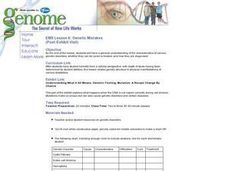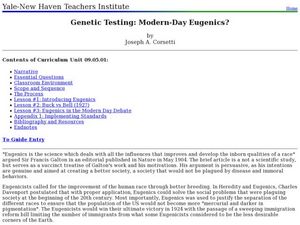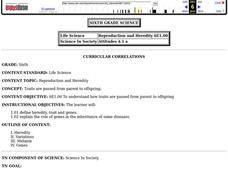Cold Spring Harbor Laboratory
Genes Don't Blend
Yellow and blue make green—unless you're studying the inheritance of genetic traits. An interactive lesson explains the difference between blended traits and pure traits and gives examples of their occurrence. The resource includes a...
Curated OER
Wearing My Genes: Basic Principles of Heredity
Students explore heredity. For this science lesson plan, students examine what heredity is, distinguish the difference between the dominant and recessive genes, explain the difference between phenotype and genotype, and predict the...
Curated OER
DNA: The Search for the Genetic Material
Students study the history of DNA and how to extract it. In this genetic lesson students complete a DNA experiment using bacteria.
Curated OER
Genetic Mistakes
Learners explore genetic disorders. They examine the genetic structure to physicial manifestations of various disabilities. Using internet sources, students analyze the characteristics of genetic disorders, whether they can be cured or...
Curated OER
Peas In A Pod: Mendelian Genetics
Students complete a series of lessons where they learn about the basics of genetics, fill out Punnett Squares correctly, and solve reality based problems. In this genetics lesson plan, students have worksheets that are provided.
Curated OER
Human Heredity Traits
Completing an idea map based on various inheritance factors and mistakes, 9th graders review their knowledge of genetic disorders. While the activity is based on chapter 15 of an unnamed textbook, the questions at the bottom of the page...
Curated OER
Genetics: Mice Rule! (Or Not)
Learners explore genetics and evolution by examining a hypothetical mouse population. Using coin tosses, they determine mouse traits of parents and offspring. Finally, they consider the outcomes of changing environmental conditions on...
Curated OER
TE Lesson: What's Dominant?
Students study the number of chromosomes in the body cells, sperm cells, and egg cells of humans. They define allele, and examine the difference between dominant and recessive alleles. They complete an activity with jelly beans that...
Curated OER
Parental Genes
Eighth graders explore how different organisms pass their traits to their offspring. In this life science lesson, 8th graders differentiate recessive and dominant alleles. They predict the phenotype based on the genotype of an organism.
Curated OER
Take Me to Sesame Street!
Students will apply concepts learned in genetics, such as Punnett squares and pedigree charts, in creating their own monster family. Also they will work cooperatively with a partner to create their monster family.
Virginia Department of Education
Mendelian Genetics
How did Mendel know which pea plants would demonstrate certain characteristics? Pupils explore the answer this question, among others, as they complete Punnet squares, research dominant and recessive traits, and explore hereditary...
Curated OER
Human Heredity II
Using deductive skills and reasoning based on the data provided about a family's blood genotype, blood phenotype, chromosomes, and genetic conditions, 9th graders answer the questions below. The conditions discussed are Down Syndrome and...
Curated OER
Human Heredity Vocabulary
Ninth graders review the terms "aneuploidy," "fetus," and "karyotype" in this vocabulary worksheet, which includes three multiple choice questions about each term. This activity could be expanded into a more developed vocabulary lesson...
Curated OER
Mendelian and Non-Mendelian Heredity
Tenth graders discuss their physical features, and why they look the way they do. They listen as the teacher discusses DNA, alleles, and dominant or recessive genes. Students perform an experiment with different colored markers...
Curated OER
Heredity Mix 'n Match
Students randomly select jelly beans that represent genes for several human traits such as tongue-rolling ability and eye color. Then, working in pairs (preferably of mixed gender), students randomly choose new pairs of jelly beans from...
Curated OER
Look Alikes
Third graders compare and contrast the physical features of parents and offspring. For this life science lesson, 3rd graders classify a set of animal pictures according to their similarities. They share and explain their work in class.
Curated OER
Genetic Testing: Modern-Day Eugenics?
Students trace the history of the development of Eugenics. In this social studies lesson, students read and analyze a real life case. They write a paper about what they read.
Curated OER
Reproduction and Heredity
Sixth graders investigate how traits are passed from parents to their offspring. They list things they have in common with family members, read key vocabulary terms, create a poster of shared physical and personality traits, and watch...
Curated OER
Heredity Worksheet #3
In this heredity activity, students complete two monohybrid crosses and predict the expected outcome of genotypes and phenotypes. They answer five questions about each genetic cross.
Curated OER
Heredity Worksheet: Dihybrid Cross
In this genetics worksheet, students use a Punnett square to determine the genotypes and phenotypes of the offspring of a dihybrid cross. Then students complete 10 fill in the blank questions.
Kenan Fellows
Unit 2: DNA Analysis
Ever wonder how they solve those mysterious murders in TV crime dramas? The second of four units in a Biotechnology series introduces scholars to the many methods of DNA analysis. Pupils create and run their own gel electrophoresis...
Curated OER
Cell Wall Recipe: A Lesson on Biofuels
Biotech engineers discover that changes in the DNA code for cell wall formation can help create crops better suited for biofuel production. They extract DNA from wheat germ. They decode paper strips with codes and relate the activity to...
Curated OER
Genetically Inherited Traits
Students explore heredity by examining how traits are passed from parent to offspring. Genetic terminology is examined and examples of inherited traits discussed. calculating genetic probability is also investigated in this lesson.
Curated OER
Twins!
Students study genetics and how twins can be identical. In this genetics lesson students research twins and how heredity, environment and personality play a part.
Other popular searches
- Heredity and Genetics
- Genetics and Heredity Labs
- Heredity and Genetics Exam
- Genetics and Heredity Songs
- Genetics Heredity Quiz
- Heredity and Genetics Ducks
- Heredity/genetics
- Genetics Heredity Punnet
- Heredity Genetics Lab

























